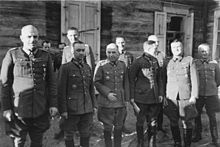Walter Weiß
Walter Weiß | |
|---|---|
 Walter-Otto Weiß (2nd from right) | |
| Allegiance | |
| Years of service | 1908 – 1945 |
| Rank | Generaloberst, Commander-in-Chief Heeresgruppe Nord, Eastern Front |
| Commands | 26. Infanterie Division Second Army |
| Battles / wars | World War I World War II |
| Awards | Knight's Cross of the Iron Cross with Oak Leaves |
Template:Foreignchar General Walter-Otto Weiß was a Wehrmacht High Command officer in World War II. He became Commander in Chief of Army Group North on the Eastern Front in 1945.
Walter Weiß joined the military service on 19 March 1908. In the beginning of World War II, during the Polish Campaign, Weiß was put in charge of I. Armee-Korps holding the position chief of the general staff. He was promoted to Generalmajor on 1 September. On 15 December 1940 he took command of the 97. leichten Division and on 15 January 1941 command of the 26.Infanterie-Division. 26.Infanterie-Division was subordinated to Heeresgruppe Mitte and participated in Operation Barbarossa. Promoted to Generalleutnant on 1 January 1942 and took command of the XXVII. Armeekorps on 1 July 1942. Again promoted on 1 September 1942, General der Infanterie Weiß led the 2. Armee on the Eastern front from 3 February 1943 on. He received command of Heeresgruppe Nord on 12 March 1945. He was held in American captivity until 1948.
1938 - 1939 Commanding Officer 1st Regiment
1939 - 1940 Chief of Staff I Corps
1940 - 1941 General Officer Commanding 97th Light Division
1941 - 1942 General Officer Commanding 26th Division
1942 - 1943 General Officer Commanding XXVII Corps
1943 - 1945 General Officer Commanding 2. Armee, Eastern Front
1945 Commander in Chief Army Group North, Eastern Front
1945 In reserve
1945 - 1948 Prisoner of War
Awards
- Iron Cross (1914) 2nd and 1st Class
- Austrian Military Merit Cross 3rd Class with war decoration
- Gallipoli Star
- Officer Cross of the Bulgarian Order of Military Merit with Swords
- Clasp to the Iron Cross (1939) 2nd and 1st Class
- German Cross in Gold (19 February 1943)
- Knight's Cross of the Iron Cross with Oak Leaves
- Knight's Cross on 12 September 1941 as Generalmajor and commander of the 26.Infanterie-Division[1]
- 646th Oak Leaves on 5 November 1944 as Generaloberst and Commander-in-Chief of the 2. Armee[1]
- Mentioned in the Wehrmachtbericht
Reference in the Wehrmachtbericht
| Date | Original German Wehrmachtbericht wording | English translation |
|---|---|---|
| 6 April 1944 | Verbände des Heeres und der Waffen-SS haben unter dem Oberbefehl des Generalobersten Weiß und unter der Führung der Generale der Infanterie Hoßbach und Mattenklott nach tagelangen harten Angriffskämpfen durch die Pripjetsümpfe bei ungewöhnlichen Geländeschwierigkeiten den feindlichen Ring um Kowel gesprengt und damit ihre Kameraden aus der Umklammerung befreit.[2] | Units of the Army and the Waffen-SS have, under the High Command of Generaloberst Weiß and under the leadership of Generals of the Infantry Hoßbach and Mattenklott, after days of harsh fighting through the Pripyat Marshes at rough terrain, broken the enemy ring at Kowel and by that our comrades were freed from the clutch. |
References
- Citations
- Bibliography
- Fellgiebel, Walther-Peer (2000). Die Träger des Ritterkreuzes des Eisernen Kreuzes 1939-1945 (in German). Friedburg, Germany: Podzun-Pallas. ISBN 3-7909-0284-5.
- Scherzer, Veit (2007). Ritterkreuzträger 1939–1945 Die Inhaber des Ritterkreuzes des Eisernen Kreuzes 1939 von Heer, Luftwaffe, Kriegsmarine, Waffen-SS, Volkssturm sowie mit Deutschland verbündeter Streitkräfte nach den Unterlagen des Bundesarchives (in German). Jena, Germany: Scherzers Miltaer-Verlag. ISBN 978-3-938845-17-2.
- Die Wehrmachtberichte 1939–1945 Band 3, 1. Januar 1944 bis 9. Mai 1945 (in German). München: Deutscher Taschenbuch Verlag GmbH & Co. KG, 1985. ISBN 3-423-05944-3.
External links
- "Lexikon der Wehrmacht". Walter Weiß. Retrieved 19 January 2008.
